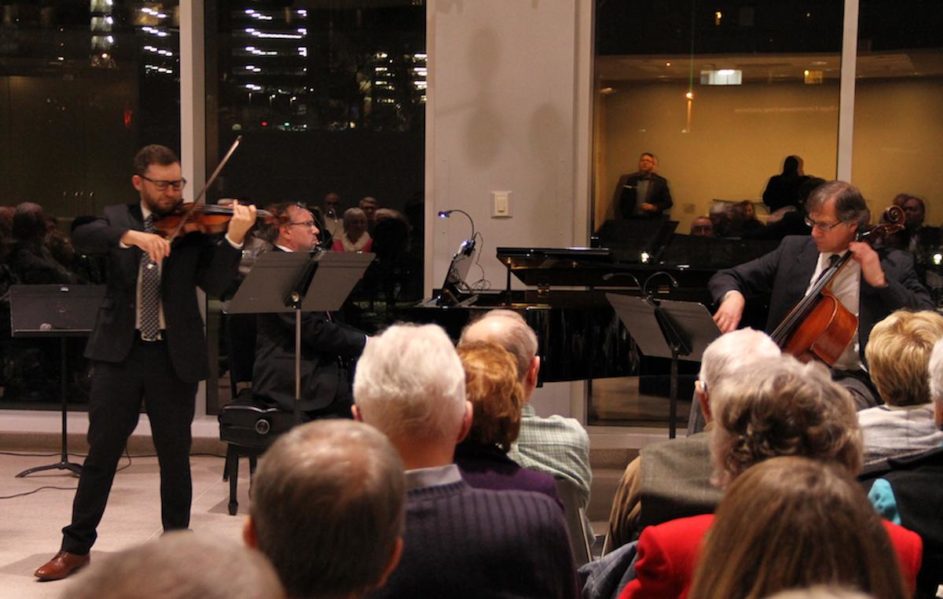Violinist William Shaub, with pianist Kevin Class, lit up the night in the Great Hall at the Knoxville Museum of Art Wednesday with a sizzling performance of French composer Camille Saint-Saens’ “Introduction and Rondo Capriccioso,” Op. 28, arranged for violin and piano.
The piece was brilliantly played by both: The piano played little skipping phrases, while Knoxville Symphony Orchestra concertmaster Shaub’s violin danced and spun fluidly on fairy tiptoes. There were smooth trills and bright, high-note flashes played at close to the upper levels of perfection that elicited roars from the audience.
It was just the beginning of an evening of music that Shaub called “epic music for an intimate audience.”
The bright acoustics of the Great Hall are ideal for such fireworks, especially for a violinist with Shaub’s virtuosic range of skills and innate musical sense. The room also brought out the warmth of a more subtle, tender piece like Alexander Glazunov’s 1891 “Meditation in D Major,” Op. 32, that Shaub and Class played next.
Shaub began the piece – almost the opposite of the Saint-Saens – with a lovely, slow, singing melody made of material that gradually returned in small pieces put together in different ways.
Then he played the meaningful symphonic intermezzo from Jules Massenet’s 1894 opera “Thaïs,” with Class playing the orchestral reduction on the piano. It’s an overt spiritual meditation that, in the opera, is played between scenes in Act II as moments of reflection.
Athanaël, a monk, has just confronted Thaïs about her hedonistic lifestyle and her devotion to Venus. He hopes to persuade her to abandon her life of pleasure-seeking and luxury and look for salvation in God. The musical interlude is intended for both Thaïs and the audience’s contemplation of Athanaël’s suggestion.
Gifted violinist Edward Pulgar then joined Shaub for “Five Duets for Two Violins,” relatively short violin pieces taken from four of Dmitri Shostakovich’s compositions. The opening “Prelude” is from Shostakovich’s score from the 1955 film “The Gadfly,” Op. 97.
“Gavotte” and “Elegy” are from Shostakovich’s “Ballet Suite No. 3,” written in 1952, taking music from his ballets “The Human Comedy” and “The Limpid Stream.” The “Waltz” section comes from “The Tale of the Priest and His Servant Balada.” The final “Polka,” also taken from the ballet “The Limpid Stream,” was part of Shostakovich’s “Ballet Suite No. 1,” written in 1950.
Generally light in character and obviously danceable, the interplay between Shaub, Pulgar and Class’s piano was a joy to hear.
Almost half of the program was dedicated to a wonderful performance of Tchaikovsky’s “Piano Trio in A Minor,” Op. 50, written in 1882 in memory of Tchaikovsky’s close friend and mentor, Nikolai Rubinstein. Cellist Andy Bryenton joined Shaub and Class for the two-movement work.
In most piano trios the piano is the workhorse, and Class didn’t get a break in this one. The piece is subtitled “À la mémoire d’un grand artiste” (“In memory of a great artist”).
The opening movement, marked “Pezzo elegiac,” began with Bryenton playing a beautiful solo on the cello that was grief-ridden, almost painfully so.
There was also a sense of frustration over the loss of Tchaikovsky’s friend that came out in Shaub’s gorgeous playing. But much of the emotional tumult showed up in Class’s rampaging piano part. The movement comes to an end in a funeral march.
Tender personal moments, with little interjections of playfulness, captured memories of someone very dear to Tchaikovsky who knew the innermost details of Tchaikovsky’s personal suffering as a closeted gay man in a world that would never have accepted him.
In the second-movement variations, there are memories of joyful times that showed up as light, flowing arpeggios in the piano, while the violin and cello played pizzicato accents.
But the trio ends with dark, brooding in the piano with the strings playing the role of mourners.
This endearing concert will be repeated again at 7 tonight in the Great Hall at the Knoxville Museum of Art. There are still some tickets remaining. Seating is general admission. Call the Knoxville Symphony box office at 865-291-3310, or order online.

